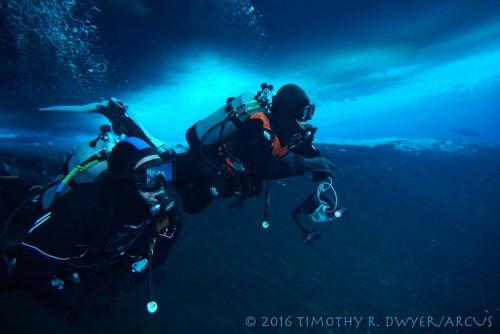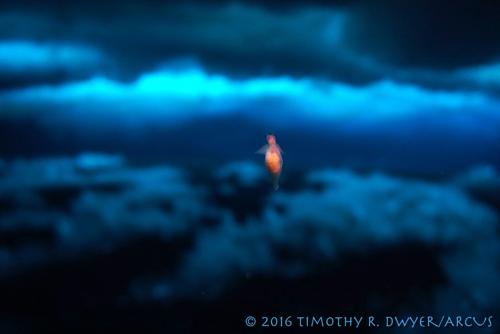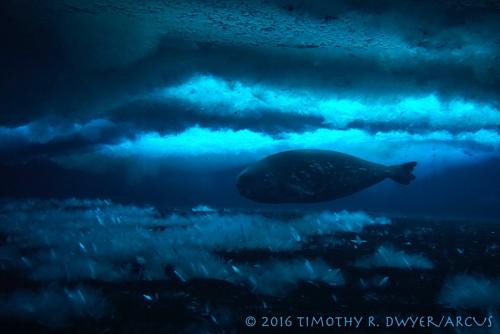In their 2012 publication, team leaders Dr. Amy Moran and Dr. Art Woods outline a number of different ideas about what allows species within certain invertebrate groups to get unusually big in the polar regions. These different suggested mechanisms for polar gigantism fall into three broad categories and are all related to the special characteristics of the ocean at the poles. In Antarctica, the water surrounding the continent is chemically different from other areas of the global ocean. It's been this way since the landmass drifted to the bottom of the world and was covered by ice some 15-13 million years ago. While extremely cold (30F/-1.8C), the Southern Ocean's temperature is also extremely stable. That stable, low temperature allows it to absorb atmospheric gases like oxygen and carbon dioxide at greater concentrations than warmer water. The currents that surround the continent are equally persistent, forming a barrier to the immigration and emigration of species and leaving Antarctic species to proceed along their own evolutionary pathways. Whatever the factors behind polar gigantism, the special nature of the Southern Ocean likely provides the environment that allows the phenomenon to occur.
 Dr. Art Woods (left) and Dr. Amy Moran, returning from a sea spider collection.
Dr. Art Woods (left) and Dr. Amy Moran, returning from a sea spider collection.
Physiology - the way in which an organism functions - possibly plays an important role in achieving large body size. The "oxygen hypothesis" suggests that body size is limited by both the availability of oxygen in the water and the rate of oxygen use by the biochemical processes that make up an organism's metabolism. When a cold-blooded organism is kept cold, high oxygen availability and low oxygen demand mean that extra tissue in a large body can be adequately supplied with oxygen. Preventing certain shell-building animals from growing large, high carbon dioxide concentrations mean that seawater pH is lower and calcium is less available to animals that build shells with calcium carbonate.
Ecology - the interactions between living organisms and their non-living environment - possibly helps explain gigantism in light of the forces isolating Antarctica. In this category, one plausible hypothesis states that "gigantic" species moved up from the deep sea, where gigantism is also common. Another suggested mechanism states that the lack of shell-crushing predators (sharks, rays, crabs, etc.) in the shallow Southern Ocean permitted certain species to achieve large bodies (think along the lines of dinosaurs and early mammals). The feast-or-famine nature of Antarctic food availability - food chain-supporting plankton only grow in the summer - might also encourage large body size because large organisms are more resistant to starvation.
Developmental biology - the processes through which organisms grow from embryo to adulthood - potentially explains unusually large body size as well. Many cold-blooded animals growing up at low temperatures grow larger than they would under warmer conditions. Egg laying polar species tend to produce fewer, larger eggs than their warmer water relatives, possibly to give offspring a better chance in an environment with long development times, brief feeding periods, and heavy competition.
 This "sea butterfly" is actually a swimming snail called a pteropod. Though tiny, pteropods exhibit polar gigantism.
This "sea butterfly" is actually a swimming snail called a pteropod. Though tiny, pteropods exhibit polar gigantism.
Drs. Moran and Woods stress that polar gigantism in a group of invertebrates might be explained by a combination of any of the potential causes mentioned above. They also make the point that the mechanisms behind unusually large body size in one group of animals may not explain it in unrelated groups. The list of possibilities is long; these scientists have traveled to Antarctica to test out some of these ideas experimentally. In the weeks ahead I'll be highlighting the work of individual researchers as they use sea spiders to test their hypotheses about why they might be giants.
 The research team's study of polar giants is limited to cold-blooded animals, so this Weddell seal is beyond the scope of their research.
The research team's study of polar giants is limited to cold-blooded animals, so this Weddell seal is beyond the scope of their research.

Comments